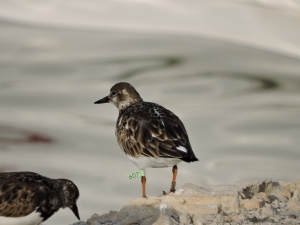For the second winter Craig Watson, ACJV Assistant Coordinator and Caleb Spiegel USFWS Region 5 Division of Migratory Birds, coordinated and carried out extensive surveys for Piping Plover and other shorebirds in the Turks and Caicos Islands (TCI). Craig and Caleb partnered with TCI Department of Environment and Coastal Resources, the Royal Society for the Protection of Birds, SWA Ltd (local consulting firm), Big Blue Unlimited (local eco-tour partner), and U.S. Geological Survey. Shorebird surveys are a critical component of the Atlantic Flyway Shorebird Initiative (AFSI), a hemispheric partnership for the conservation of 15 Focal Species, including Piping Plover. This work spawned from recent work conducted in the Bahamas to locate wintering Piping Plover, and because TCI is a part of the Lucayan Archipelago to which the Bahamas belong, it was thought that Piping Plover may winter there. Significant numbers of Piping Plover were located in the Bahamas, and with Caleb’s expertise from the Bahamas work and his ability to recognize suitable habitat on Google Earth, locations throughout TCI were chosen to survey. Ninety-six Piping Plover were located in the winter of 2016, three of which were flagged and from the northeast United States and eastern Canada. Additionally, over 3,000 individuals of 17 other shorebird species were recorded, most of which were relatively unknown in TCI prior to this census. This information has led to the proposed expansion of several National Parks in TCI and the proposed expansion of the RAMSAR site in TCI.
Partners believed that several key sites were overlooked in 2016. To ensure that all priority places are surveyed to determine exact wintering populations, another significant effort was launched in the winter of 2017. Added to the existing partnership was a well known and experienced contractor hired by Environment and Climate Change Canada to relocate the Canadian banded plover. With knowledge and experience gained from last year’s effort, there were essentially two teams that were available for surveys this season rather than the one inexperienced team last winter. The results were greater than expected, resulting in the detection of 174 Piping Plover with eleven banded individuals, and over 7,000 shorebirds of 23 species being observed. A most surprising discovery was the detection of a significant wintering population of Red Knot. Relatively unknown and occurring in low numbers in TCI (<6), over 400 individuals were observed on one occasion, and over 80 on another, with three individuals being tagged with green flags.
With two years of data, and with very significant detections for 23 species of shorebird, particularly the Piping Plover and Red Knot, a basis for establishing an Important Bird Area (IBA) or multiple IBAs is being explored. Significant numbers of AFSI focal species were detected including: Short-billed Dowitchers, Black-bellied Plover, American Oystercatcher, Wilson’s Plover, Ruddy Turnstone, Sanderling, Lesser Yellowlegs, and Semipalmated Sandpiper. There is more to learn about shorebird abundance and distribution in TCI, as many prime areas again were not able to be explored this season. Future efforts should occur during the winter to explore other potential wintering areas for Piping Plover and other wintering shorebirds, and seasonal surveys in spring and fall migrations are being discussed with partners in TCI. With the great spirit and partnership built during these first two years, these efforts are resulting in adding protected acreage to the landscape, and providing valuable information to the planning authorities for future developments planned in TCI, conserving valuable resources previously unknown in this British Territory.




